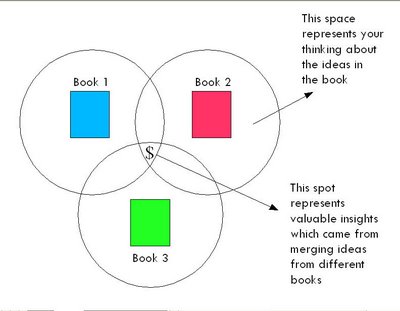Generating insights from merging ideas
 The above diagram illustrates an important phenomenon, I think.
The above diagram illustrates an important phenomenon, I think.It's the idea that valuable insights ("valuable" in the sense that you can develop new products or services or ways of competing commercially) can be discovered when you merge the thinking of various books.
This is like the well-known principle in metallurgy whereby an alloy, which is made up of different metals, is stronger than a single metal.
It's important to note that you can't really merge "books"; you can only merge the ideas or, better yet, your own understanding of the content of each book.
A book may contain information of the "fuel" type whereas another book may contain information or ideas of the "oxygen" type. By mixing them together, you get combustion, hence energy.
Where does this mixing take place? In the human mind, of course.
Without this mixing in the human mind, books remain very static, quite valueless (as when they gather dust on a bookshelf or in a library).
Another place where this (potentially explosive) mixing occurs is in a conversation. Einstein knew this, which is why he created the Olympian Academy, an informal group that got together in coffeehouses to debate and discuss ideas in science.
Bill Gross, the well-known entrepreneur, for his part uses a different method for mixing ideas. He would read magazines, books, newspapers, etc. and record (in an Excel sheet) interesting ideas that he comes across. Then, he would rate these ideas using various criteria, and I'm guessing that he would perform various permutations and combinations to see the "offspring" of various ideas merging.
Not surprisingly, he's always full of million-dollar ideas!
Remember: this technique is what he shared with the media. Imagine all the secret techniques he uses to combine ideas, which he does not share with the public.

<< Home